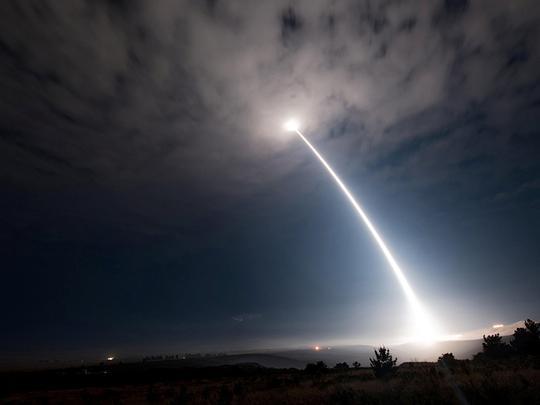
Los Angeles: An unarmed intercontinental ballistic missile was launched from Vandenberg Air Force Base early on Wednesday to test the weapon’s reliability to “defend against attacks on the United States and its allies”, the Air Force said.
The Minuteman III missile was fired at 2.10am local time from the base northwest of Santa Barbara, California, according to the Air Force Global Strike Command. The missile, equipped with a single test re-entry vehicle, travelled 6,759km to a test range near the Kwajalein Atoll in the Marshall Islands.
The strike command said the test was “not a response to recent North Korean actions.” Rather, the launch “demonstrates that the United States’ nuclear enterprise is safe, secure, effective” and can protect against strikes, the command said.
The test comes after North Korea launched an intercontinental ballistic missile on Friday — the second in less than a month. The two-stage missile crashed off the coast of Japan’s northernmost island, Hokkaido. Independent defence analysts say such a missile may be capable of reaching California and other parts of the West Coast.
On Tuesday, Secretary of State Rex Tillerson said the US government would agree to a dialogue with North Korea if it relinquishes its nuclear programme.
“We are trying to convey to the North Koreans: ‘We are not your enemy, we are not your threat. But you are presenting an unacceptable threat to us, and we have to respond’,” he said.
US Secretary of State Rex Tillerson urged continued “peaceful pressure” on North Korea, even as one Republican senator ratcheted up talk of war.
Taking stock of his tenure after six months in office, Tillerson told reporters at the State Department Tuesday that the US goal isn’t to topple Kim Jong-un’s regime or find “an excuse to send our military north.” Instead, he said, it’s to get the regime to develop the “willingness to sit and talk with us and others, but with an understanding that a condition of those talks” is North Korea giving up its nuclear weapons capability.
It was a decidedly less confrontational tone than that of Republican Senator Lindsey Graham, who told NBC Tuesday that “there is a military option — to destroy North Korea’s programme and North Korea itself.”
“There will be a war with North Korea over their missile programme if they continue to try to hit America” with an intercontinental ballistic missile, Graham said. President Donald Trump “has told me that. I believe him, and if I were China, I would believe him too and do something about it,” Graham said.
Asked about the South Carolina senator’s suggestion, White House press secretary Sarah Sanders said Trump has been “very outspoken” about “keeping all options on the table.”
China’s Role
Tillerson also underscored China’s key role in diplomacy with North Korea, through its “special and unique relationship” with the isolated nation. China can “influence the North Korean regime in ways that no one else can,” he said.
Trump said on Twitter on Saturday that he was “very disappointed in China.”
“Our foolish past leaders have allowed them to make hundreds of billions of dollars a year in trade, yet ...” he tweeted, “ ... they do NOTHING for us with North Korea, just talk. We will no longer allow this to continue. China could easily solve this problem!”
In his rare appearance before reporters at the State Department, Tillerson defended his efforts to translate Trump’s “American First” slogan into a foreign policy that can engage other nations.
“When we say, ‘America first,’ it doesn’t mean America alone,” Tillerson said.
Wednesday’s launch was conducted by Vandenberg’s 30th Space Wing team, the 90th Missile Wing at F.E. Warren Air Force Base in Wyoming and the 576th Flight Test Squadron, the Air Force said. The 90th Missile Wing is one of three bases overseeing the country’s intercontinental ballistic missile forces.
The test is the fourth ICBM launched from the base this year.
“These test launches require the highest degree of technical competence and commitment at every level and provide critical data necessary to validate the reliability, accuracy and performance of the ICBM force,” Col. Dave Kelley, 576th Flight Test Squadron commander, said in a statement.
In February, a test missile was launched from the base. That missile was also equipped with a nonexplosive payload and travelled to the Marshall Islands.
Another test was conducted by the Air Force Global Strike Command’s team on April 26. Air Force officials said that launch was an operational test to show the country’s nuclear deterrent capability.
Days later, a third test missile launched from the base. The unarmed Minuteman III missile was launched just after midnight on May 3 from the base to test the weapon’s reliability and ensure an “effective nuclear deterrent,” according to the Air Force.
On May 30, the Missile Defence Agency conducted a flight test exercise of a ground-based interceptor that was also launched from the airbase. The interceptor successfully targeted and destroyed an unarmed intercontinental ballistic missile launched from the Marshall Islands.












